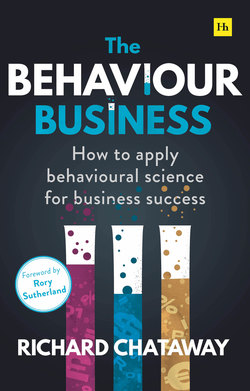Читать книгу The Behaviour Business - Richard Chataway - Страница 3
На сайте Литреса книга снята с продажи.
ОглавлениеContents
About the Author
Preface
What this book is about
Who this book is for
How this book is structured
Foreword by Rory Sutherland
Introduction
Part One: How to Create a Behavioural Business
Chapter 1: Undoing Economics – A New Way of Thinking
Undoing economics
Why is behavioural science important for business?
Two systems of thinking – designing for Homer
How behavioural science changes how we think about business decision-making
Chapter 2: Nudging For Good – How Governments Use Behavioural Science
How to change an irrational behaviour: smoking
Nudging for good
Behavioural government
Nudging through technology: My QuitBuddy
Chapter 3: Test-Tube Behaviours – How to Deliver Marginal Gains Using Behavioural Science
‘Sciencing the shit’ out of problems
Learning from failure
Applying a growth mindset to business challenges
The value of testing
Chapter 4: How to Create a Behavioural Business
What to Do Now
Part Two: Delivering in Digital with Behavioural Science
Chapter 5: How Digital Got its FANGs – the Behavioural Science of Digital Business
‘Making it easy’ in digital
Making search easy: Google
Using data to leverage social proof: Netflix
Creating addictive products: Amazon
Chapter 6: Digital and the Growth Mindset – the Lean Approach to Using Behavioural Science
Testing using behavioural data
How Facebook embeds test-tube behaviours
Applying this approach
Chapter 7: The Dark (and Light) Side of Digital – a Warning About Ethically Influencing Behaviour
Are you using data ethically – and legally?
Are the outcomes of the behaviour positive or negative?
What are the implications of creating an addictive product or service?
Chapter 8: Behavioural Science in Digital
What to Do Now
Part Three: How Behavioural Science Helps Us Better Understand AI, Robots – and People
Chapter 9: Humans Versus Machines – How Behavioural Science Creates Better Products and Services for Humans, and Robots
Monkeys, cucumbers, and grapes
Irrational human behaviour or ‘bugs’?
The AI gold rush
Humans versus algorithms
The limits of AI – a question of trust
Chapter 10: Predicting Behaviour and Eliminating Noise – Behavioural Science and Automation
Prediction machines
Better predictions with behavioural science
Removing ‘noise’
The dangers of inconsistency
Technology, behaviour and data
Chapter 11: Artificial Irrationality – How Behavioural Science Helps Businesses Ethically Use AI and Automation
The importance of distinguishing between human and robot
The ethics of AI and automation
Businesses must take the ethical AI lead
How AI can help identify bias
Better training data – how behavioural science helps businesses ethically use AI and automation
Chapter 12: AI, Automation and Behavioural Science
What to Do Now
Part Four: Boosting Productivity with Behavioural Science
Chapter 13: The Rise of the Machines, and the Future of Work – Behavioural Science and a Changing Workforce
Will a robot be stealing your job?
Psychological solutions will be needed to solve economic problems
Losing your job to a robot may not be a bad thing – if it’s a bad job
Losing work does not lead to bad decisions – but financial (and time) poverty does
What behavioural science tells us about how we view work
Chapter 14: The Science of Motivation – How to Provide Good Work and Nudge the Right Behaviours from Your Teams
What is good work?
More money doesn’t transform bad work into good work
Bad work is bad for business
Creating good habits at work
Think about your environment
Normalising good behaviour and providing positive motivation
Chapter 15: Building Effective Teams Using Behavioural Science – Finding and Maintaining Success
Recruitment: the traditional home of psychology in business
Recruiting the right people for the right reasons
Assessing potential and predicting success
Test-tube recruiting
Training is not enough
Diversity is good for business
Generating psychological safety
Chapter 16: Behavioural Science in the Workplace
What to Do Now
Part Five: Behavioural Science and Your Customers
Chapter 17: The Dangers of Post-rationalisation – How Behavioural Science Demonstrates That Much Market Research is Flawed
The Oval Office and the Press Office
Telling stories in research
We are poor prediction machines
The role for traditional market research
Chapter 18: The Importance of Subconscious Associations – Understanding How People Buy, at Home and in Business
Why are subconscious associations important?
How subconscious associations influence how we buy
We are predictably irrational at work as well as at home
Homer in the city
Focus on satisficers, not maximisers
Helping customers make easy, good enough decisions
Chapter 19: Gaining Advantageous Insights – Techniques and Tools to Better Understand Customers
Recreating context
Knowing if you will be noticed
Subconscious associations – knowing what people really think
Preventing post-rationalisation and improving predictions: observing behaviour
Chapter 20: Behavioural Science and Your Customers
What to Do Now
Part Six: Behavioural Science for Better Marketing
Chapter 21: The Myth of the Rational Consumer – How Behavioural Science Explains How Marketing Works
Homer ignores most marketing
Direct (behavioural) marketing
Focus on what you should measure, not what you can measure
The marketing science heretics
Chapter 22: Brands as Heuristics – What Behavioural Science Tells Us About Brands
Consistent brand assets
Be distinctive
The importance of context: costly signalling
Consistency, distinctiveness and costly signalling: ING Direct
Chapter 23: Marketing Science – How Behavioural Science Delivers Better Marketing (and Combats Marketers’ Biases)
Mental and physical availability
Precision targeting means targeting no one – or only fellow marketers
Focus on light buyers
Physical availability
Chapter 24: Behavioural Science for Better Marketing
What to Do Now
Conclusion
Beating overconfidence – accepting what we don’t know
Innovation is driven by learning from mistakes
Science drives creativity – and vice versa
How to create a behavioural business
Acknowledgements
Publishing details
